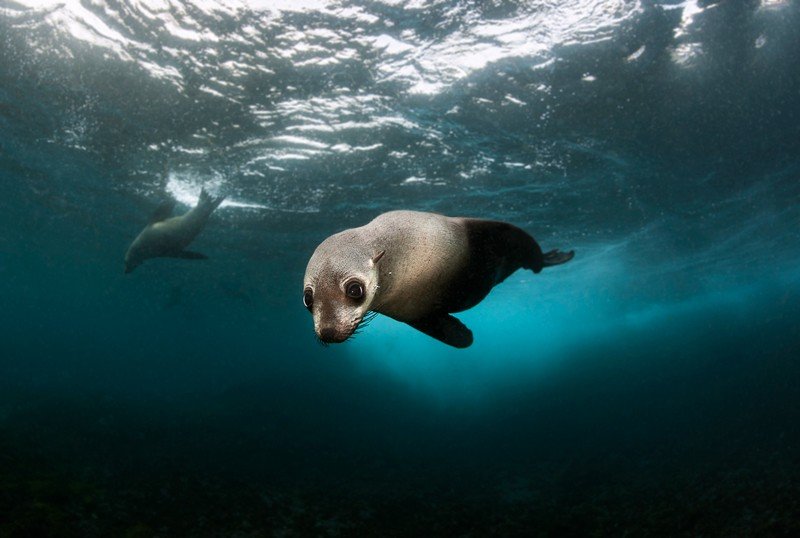
Fish farming
Not the sustainable solution to commercial fishing it is marketed to be.
In a bid to keep up with the expanding global demand for seafood, the popularity of farmed fish is increasing. Half of all seafood eaten around the world now comes from a farming system known as “aquaculture”. Aquaculture, otherwise referred to as “aquafarming”, is the cultivation of aquatic animals for food.
Australia has numerous farmed fish operations across the country, both on land and off the coast. Fish farming is associated with several devastating environmental impacts, which differ depending on the species being farmed.
Many farmed fish species are carnivorous and rely upon wild-caught populations for feed. Meaning wild fish must be caught in order to feed the growing populations of fish raised in farms. Over 50% of global fish oil is utilised in feed for farmed salmon. Implicating aquaculture in overfishing and by-catch, which are devastating the health of our oceans.
Generating waste
Fish farms also generate a large amount of waste, impacting the surrounding environment and ecosystem. Waste produced by fish farms located in the water spills out into the ocean, causing nitrogen pollution, which can lead to depletion of oxygen in the water and can kill aquatic plants and wild populations of fish.
Further, vast amounts of antibiotics and pesticides are used in aquaculture as a means to reduce prevalence of disease, which can also impact wild populations of marine animals. Though no antibiotics are currently registered for use in Australian aquaculture, the “off-label” use of antibiotics is not monitored.
Impacting wild populations of fish
The health of farmed fish populations is hugely impacted by the way they are raised. The close confinement with thousands of other fish means disease can spread rapidly. A common disorder in farmed fish is amoebic gill, which is caused by a parasite that thrives in warm water. This is particularly concerning given the projected increase in water temperatures due to climate change. This disorder is characterised by difficulty breathing and deteriorated gills, and can have a high mortality rate if left untreated. Unsurprisingly, this disease can spread to wild fish populations, risking further declines in wild populations.
Unfortunately, the broader environmental impacts of fish farming do not end there. Genetic disruption of wild fish populations is another risk factor associated with aquaculture.
Fish farmed in underwater sea cages often escape, posing a risk of them reproducing with wild populations.
Salmon, for example, escape from fish farms in the millions every year. Though this may seem inconsequential, it can significantly damage wild populations of fish by introducing negative genetic traits and eroding wild gene pools.

Projected growth to cause devastation
Despite the impact on wild-living animals, and the wider ecosystem, projections predict the aquaculture industry to double in size by 2030. Such rapid growth would greatly exacerbate already existing threats including depletion of wild populations of fish through demand for feed, the prevalence of parasites and high mortality rates among fish ‘stocks’.
The growth of the industry has, for example, resulted in low levels of dissolved oxygen in Macquarie Harbour. This was a contributing factor in the deaths of approximately 1.35 million salmon and trout in 2018. Others endure disease due to cramped environments in sea cages. These problems are expected to increase due to climate change. Such issues support the conclusion that the industry is unsustainable and poses a series of unacceptable ecological and animal welfare risks.
Seals and seabirds; collateral damage of fish farming
Aquaculture, particularly the farming of Atlantic salmon, has been growing rapidly in Tasmania.
Due to the nature of the production system, Atlantic salmon are vulnerable to predation by seals or sea birds, with seals entering fish pens in search of food.
Seals
In 1975, all seals in Australian Commonwealth and State waters became protected, following decades of commercial hunting.
While some populations have shown signs of recovery, others have not.
Despite being a protected species, Australian fur seals have been subjected to relentless control by the Tasmanian salmon industry, and whilst other Australian states impose up to six-figure fines for the killing of a seal, the same is regarded as “fishery management” in Tasmania. Consequently, nets, seal barriers and a range of other measures have been used by the Tasmanian salmon industry since the 1990s.
The industry uses several techniques to “deter” seals, designed to deter them from entering or remaining in a particular area. Under Tasmanian regulations this may include “the use of explosives, the discharge of a projectile, or the use of a chemical substance”.
Learn more about Australia’s killing of seals here.
Seabirds
Seabirds attempt to enter aquaculture pens in search of food, and can become entangled in netting, often resulting in serious injury or death.
Many of the welfare impacts described in the fencing and netting section apply here.
Moving forward
Explore some of the solutions available to the current issues facing our marine environment on the previous page.
Join the Wildlife Protection Commitment
For socially responsible brands, businesses and institutions looking to reduce their impact on native wildlife.

Stay up to date with us
Receive email updates on the progress of Defend the Wild and our latest campaigns by signing up to our mailing list.






